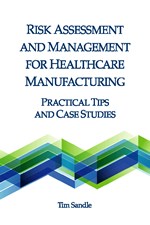Risk Assessment and Management for Healthcare Manufacturing: Practical Tips and Case Studies
- Format
- Book
- Member Price
- $240.00
- Nonmember Price
- $299.00
Please sign in or become a member to purchase items from the PDA bookstore.
Avoidance of hazards and assessment of risk have long been part of the manufacture of pharmaceuticals and healthcare products. A high quality drug product must be free from contamination and reliably deliver the intended therapeutic dose as stated on the label and to achieve this manufactures must always be mindful of risk.
Tim Sandle's newest book incorporates regulatory perspectives, scientific methods and practical examples to describe approaches to problem solving when assessing, managing and reviewing risk. The book is divided into four sections that present a formal approach to risk. The first section provides a look at risk assessments and hazards, exploring the origins, looking at key concepts and philosophies and assessing the regulatory perspective. An overview of available tools for risk assessment and problem solving leads into specific 'soft skills' that can help to run an effective meeting, oversee a project and report root cause analysis and risk outcomes. The book concludes with an extensive set of case studies to show real-world applications of the tools and techniques presented. The wide range of topics presented throughout the four sections includes risk considerations for aging pharmaceutical facilities, application of quality risk management to cleanroom design and process incident investigation.
Table of Contents
Table of Contents:
Click here to download >>>Detailed Table of Contents
- Introduction
Part A: Risk Assessment and Hazards
- Risk Assessment and Risk Management
- Regulatory Perspectives on Risk
- Pharmaceutical Processing Hazards
- Root Cause Analysis
Part B: Risk Assessment Tools and Problem Solving Approaches
- Question Based Approaches: The "Five Whys" and "What if" Methods
- Is/Is not Approach
- Simple Risk Assessment Tools
- Fishbone (Ishikawa) Diagram
- Contradiction Matrix and Knot Charts
- Pareto Charts and Control Charts
- Hazard Analysis and Critical Control Points
- Failure Modes and Effects Analysis
- Monte Carlo Method
- Fault Tree Analysis
- Hazard and Operability Study
- Six Sigma and Associated Quality Tools
Part C: Practical Tips
- Effective Meetings and the Process of Brainstorming
- Project Management and Research
- Reporting Risk Outcomes
Part D: Case Studies
- Application of Quality Risk Management to Cleanroom Design
- Case Study: Hepa Filter Failure
- Aseptic Transfer Risk Assessment: A Case Study
- Importance of Risk Assessment for Aseptic Transfer in Pharmaceutical Compounding
- Risk Assessment for Intervention Scoring in Relation to Aseptic Processing
- General Considerations for the Risk Assessment of Isolators Used for Aseptic Processes
- Risk Considerations for the Use of Unidirectional Airflow Devices
- Risk Consideration for Aging Pharmaceutical Facilities
- Process Incident Investigation
- Addressing Manufacturing Constraints by Increasing Production Throughput
- Risk Assessment of Production Formulation Stages
- Risk Based Approach to Internal Quality Auditing
- Risk Assessment for Data Integrity
- Assessment of Raw Material Handling and Expiration
- Risk Management and the Supply Chain
- Risks Associated with Clinical Trials
- Application of Risk Assessment to Develop an Environmental Monitoring Program
- Detection and Risk: Environmental Monitoring Data Deviations
- Application of Risk Assessment for Personnel Safety
- Risk Considerations for the Installation of a New Pharmaceutical Facility Autoclave
- Safety Risk Assessment for the Ozonation of a Purified Water System
- Error Risk Reduction: Concept and Case Study
About the Authors
About the Author
Tim Sandle has over twenty-five years of experience in pharmaceutical microbiology. Tim is the site microbiologist at the Bio Products Laboratory and he is a visiting tutor at the University of Manchester, where he teaches pharmaceutical microbiology. In addition, Tim is a longstanding committee member of the Pharmaceutical Microbiology Interest Group (Pharmig). Tim has worked on a number of different microbiological projects including developments in the testing of bacterial endotoxins and pyrogens; validation of culture media; establishing the environmental monitoring regime for a network of over two hundred clean rooms; qualifying several water systems; and validating a sterility testing isolator system. Tim has authored over three-hundred papers, articles and book chapters in relation to microbiology; and he has written or edited ten books.

